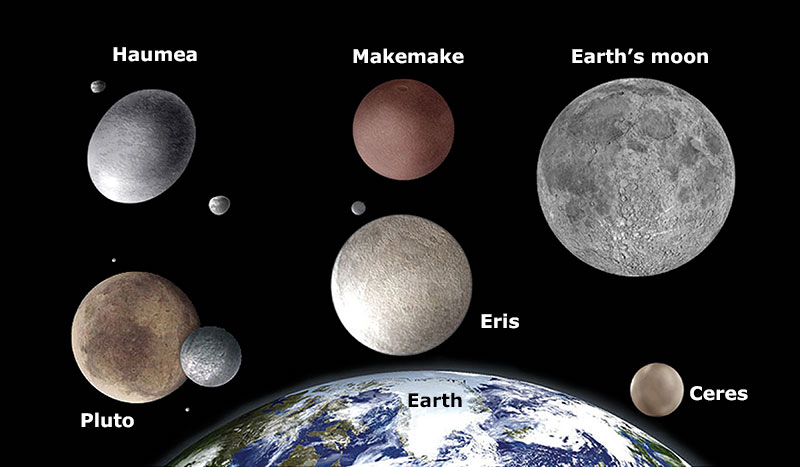Makemake << MAH keh MAH keh >> is a dwarf planet in the outer solar system. A dwarf planet is an object orbiting the sun that is smaller than a planet but larger than a comet or asteroid. As seen from Earth, Makemake is the second brightest object in the Kuiper belt, a region of icy bodies beyond the orbit of Neptune. Only Pluto is brighter.

Makemake is about 888 miles (1,430 kilometers) in diameter. It spins once about its axis every 22.5 hours. Makemake orbits at an average distance of 4.3 billion miles (6.8 billion kilometers) from the sun. One complete orbit takes about 305 Earth years. Because of its distance from the sun, Makemake has extremely low surface temperatures, around 30 K (–243 °C or –406 °F). Makemake is reddish in color, like Pluto. Makemake’s surface is likely covered with frozen pellets of methane as large as 0.4 inch (1.0 centimeter) in diameter. Other ices, such as ethane, also are found on the surface.
The American astronomers Michael E. Brown, Chadwick A. Trujillo, and David L. Rabinowitz discovered Makemake on March 31, 2005. They found it in pictures taken using the Samuel Oschin Telescope at Palomar Observatory in southwestern California. The Minor Planet Center assigned the newly discovered object the temporary designation 2005 FY9. The center is part of the International Astronomical Union (IAU), the widely recognized authority in naming heavenly bodies. People sometimes informally referred to 2005 FY9 as Easterbunny, a nickname used by the object’s discoverers. In 2008, they named the object Makemake, for the creator of humanity and god of fertility in the mythology of the Polynesian settlers of Easter Island.
On April 23, 2011, Makemake passed in front of a distant star, partly blocking the star’s light. From observations of this event, astronomers were able to determine that the dwarf planet has no atmosphere. Observations made by the Hubble Space Telescope in 2016 suggest that Makemake may have a small moon.
Makemake was discovered around the same time as Eris, an object in the Kuiper belt about the same size as Pluto. These discoveries intensified an ongoing debate over the definition of the term planet. At the time, Pluto was widely considered the ninth planet. In 2006, the IAU created the term dwarf planet to describe Pluto, Eris, and other similar objects in the solar system. In 2008, the IAU also classified Eris, Pluto, and the other dwarf planets beyond Neptune as plutoids.
